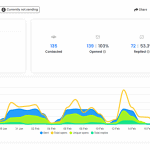If there’s one thing that inbound marketing requires for every company in every industry, it’s time.
Creating your marketing strategy, coming up with blog topics, generating content, managing your social media accounts…the list of marketing tasks to do goes on and on.
Fortunately for busy marketers, there is a way to ease this time crunch: inbound marketing automation. As the name suggests, inbound marketing automation is simply the name given to software tools that are designed to help business owners and marketers make smarter, more informed decisions about their marketing campaigns.
Before we discuss how inbound marketing automation can help your business, let’s take a more focused look at what this concept typically entails and talk about what inbound marketing automation is and what it isn’t.
A Closer Look at Inbound Marketing Automation
First of all, if you were hoping that inbound marketing automation would be a quick fix, “set and forget” type of solution, you are sorely mistaken. Whether you automate or not, inbound marketing will still require plenty of time and effort.
 At its core, inbound marketing automation is about automating the process of gathering and organising data about your existing prospects so that you can more effectively make decisions about your marketing campaign. In their basic guide to marketing automation, HubSpot warns potential users of automated marketing that this technique is not one that can be used for generating leads.
At its core, inbound marketing automation is about automating the process of gathering and organising data about your existing prospects so that you can more effectively make decisions about your marketing campaign. In their basic guide to marketing automation, HubSpot warns potential users of automated marketing that this technique is not one that can be used for generating leads.
In fact, HubSpot advises its readers that one of the most common situations that leads to marketing automation failure is when a marketer pays for a huge list of unknown leads and attempts to nurture them with marketing automation. In many cases, this approach relegates your carefully crafted messages and marketing correspondence to the dark recesses of your targets’ junk mail folders.
So what exactly does inbound marketing automation help with? There are several elements of automation that are valuable for marketers that want to do a better job at nurturing their leads, such as:
- Lead scoring: have you ever wondered how likely it is that your leads will actually convert into sales? Marketing automation software allows you to do a better job of predicting how hot your leads are by scoring them based on your customised profile of an ideal customer
- Email marketing automation: everything from the timing of your messages to the way your leads are segmented when this correspondence is sent out can be automated by marketing software that uses in-depth analysis to help you decide on an ideal strategy for email campaigns
- Social media marketing and analytics: wondering which of your social media posts are getting the most attention amongst which group of prospects? Are you curious about how your social media activity is actually impacting website traffic? Social media analytics can give you all of this information, and more
 Sounds pretty good, right? The truth of the matter is that these functions make up just a small fraction of what is possible with automated marketing. The only way for you to determine exactly which automation tools work for you and which ones do not is by dipping your toes in the water and testing them out.
Sounds pretty good, right? The truth of the matter is that these functions make up just a small fraction of what is possible with automated marketing. The only way for you to determine exactly which automation tools work for you and which ones do not is by dipping your toes in the water and testing them out.
Getting Started With Inbound Marketing Automation
Before you determine exactly which kind of inbound marketing platforms are best for your requirements, it is wise to have a strong idea of what your goals are. Maybe you are looking to get a stronger understanding of social media metrics so you can do a better job of appealing to prospects on this medium, or perhaps you want to determine how to optimise your landing page to receive the most newsletter signups.
Whatever the case may be, you must have a strong sense of what your goals are for marketing automation: otherwise, you run the risk of wasting time and money on a sophisticated marketing platform that doesn’t do what you need it to.
After making this decision, you should understand which of the popular inbound marketing automation platforms is right for your company.  Some of the more common platforms used by today’s marketers for automation include HubSpot, Pardot, and Marketo. There are also marketing automation platforms that are designed to handle one specific task: for example, MailChimp is one of the most popular automation tools for sending marketing e-mails and tracking their results.
Some of the more common platforms used by today’s marketers for automation include HubSpot, Pardot, and Marketo. There are also marketing automation platforms that are designed to handle one specific task: for example, MailChimp is one of the most popular automation tools for sending marketing e-mails and tracking their results.
Finally, never forget that no matter how advanced your marketing tools are, at the end of the day you are still looking to attract real human beings to your organisation and what it has to offer. Some companies get so caught up in automated e-mails, conversion forms, and lead segmentation that they lose the human element of their business: don’t let this happen to you.
Put yourself in the shoes of your prospects and think about what kind of impression they might get from your marketing correspondence. One simple guideline to help you in this regard: the easier it is for your prospective customers to tell that they are being sent automated marketing correspondence, the less likely it is that they will respond or be engaged by this correspondence.
With a clear understanding of your goals, the right marketing platform, and a healthy dose of perseverance, it is very possible for your business to successfully use inbound marketing automation to take your marketing campaign’s ROI to new heights.
- How Videos Can Be Used in Email Marketing for More Engagement - April 4, 2022
- Attention Home Builders: Here’s How to Educate, Engage and Win Over Potential Customers - October 19, 2020
- The Best Digital Marketing Framework for High Ticket Businesses - September 14, 2020



